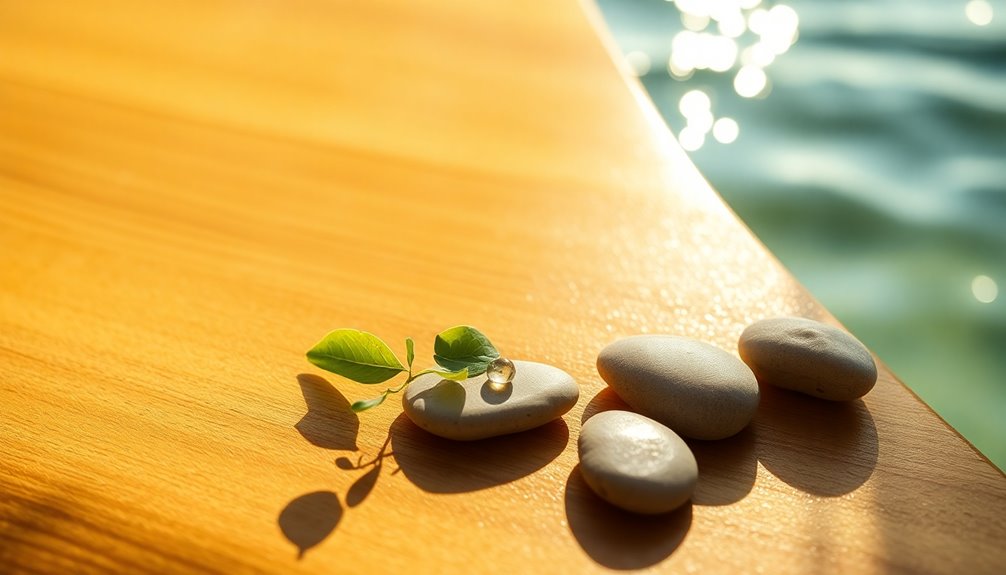Nature-inspired minimalism invites you to explore a design philosophy that celebrates organic forms and sustainable materials. It emphasizes a connection to nature, creating spaces that are both calming and inviting. As you consider the elements that define this aesthetic, think about how fluid shapes and earthy colors can transform your environment. What are the key components that make these designs so appealing, and how can you incorporate them into your own space?
Key Takeaways
- Nature-inspired minimalism emphasizes fluid shapes and organic forms, creating inviting and tranquil spaces that reflect the beauty of the natural world.
- Earthy tones, such as soft browns and muted greens, enhance the calming atmosphere and foster a connection to nature.
- Incorporating sustainable materials, like reclaimed wood and natural textiles, supports eco-friendly design while adding warmth and character to interiors.
- Layering textures, from smooth stones to chunky knits, creates visual interest and depth, promoting a cozy yet minimalist aesthetic.
- Biophilic design principles, such as maximizing natural light and integrating indoor plants, enhance well-being and connection to the environment.
Understanding Nature-Inspired Minimalism

When you explore nature-inspired minimalism, you'll discover a design philosophy that seamlessly blends organic forms and natural materials to create serene spaces.
This approach emphasizes a soothing palette of earthy tones, like soft greens and browns, fostering tranquility and a deep connection to nature.
You'll find fluid shapes in furniture and decor, offering a welcoming contrast to the rigid lines of traditional minimalism.
Incorporating indoor plants and maximizing natural light enhances the indoor-outdoor connection, promoting overall well-being.
Additionally, the use of sustainably sourced materials not only adds character but also aligns with eco-conscious practices, ensuring your space is both beautiful and responsible.
Ultimately, nature-inspired minimalism nurtures harmonious spaces that reflect the beauty of the natural world. Furthermore, utilizing sustainably sourced materials supports practices that minimize pollution and contribute to environmental well-being.
Key Characteristics of Organic Forms
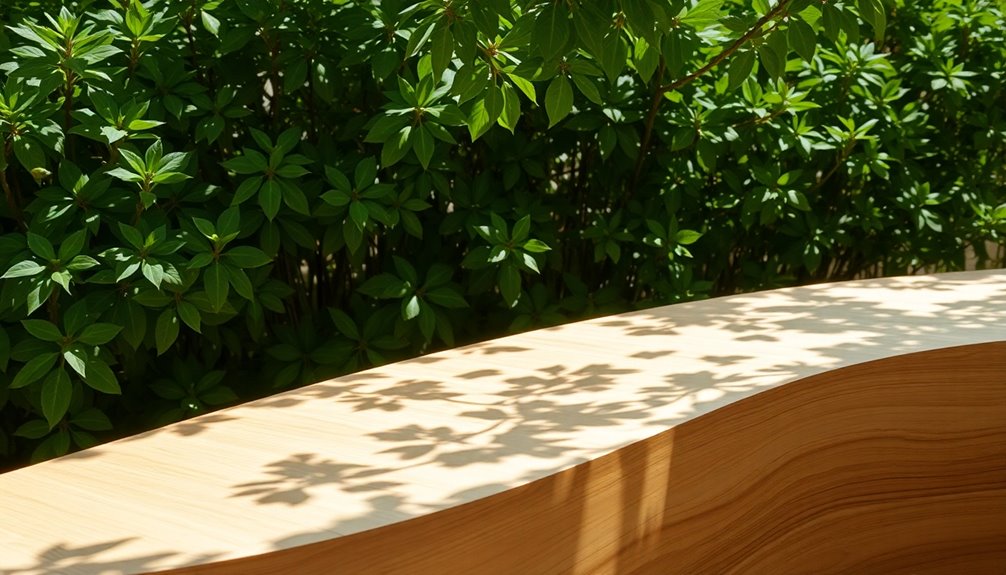
When you explore organic forms, you'll notice how fluid shapes and lines create a welcoming atmosphere. These designs often draw inspiration from nature, incorporating textures and materials that reflect the environment's beauty. Additionally, the use of sustainable materials is essential in achieving a luxurious yet eco-friendly aesthetic.
Fluid Shapes and Lines
How do fluid shapes and lines influence the ambiance of a space? They create an inviting atmosphere, promoting comfort through gentle contours and organic forms.
By incorporating fluid shapes, you foster a natural flow that contrasts with rigid modern designs. This minimalist approach softens the overall aesthetic, adding warmth and texture to your surroundings.
Think of arched doorways and rounded furniture that evoke nature's beauty, enhancing the tactile experience. These elements encourage a harmonious living environment, making your space feel more connected to the natural world.
Embracing fluid lines reflects principles of biophilic design, allowing you to create spaces that not only look beautiful but also resonate deeply with the human experience. Additionally, the use of natural materials like wood and bamboo can further enhance the organic feel of your interior design.
Nature-Inspired Textures and Materials
Nature-inspired textures and materials form the backbone of a serene and inviting space. By incorporating natural materials and organic forms, you create a peaceful retreat that fosters tranquility.
Here are three key elements to contemplate:
- Layered Textures: Combine smooth and rough surfaces like polished wood and rugged stone, or soft fabrics such as linen and wool to add depth and warmth.
- Earthy Tones: Utilize soft neutrals and earthy colors to enhance the calming atmosphere, reflecting the natural world around you.
- Sustainably Sourced and Reclaimed Materials: Opt for eco-friendly choices that not only add warmth and character but also contribute to a minimalistic and inviting environment. Additionally, consider integrating eco-friendly gardening practices that promote a healthier living space.
Embrace these elements to transform your space into a haven of nature-inspired minimalism.
Incorporating Natural Materials in Design
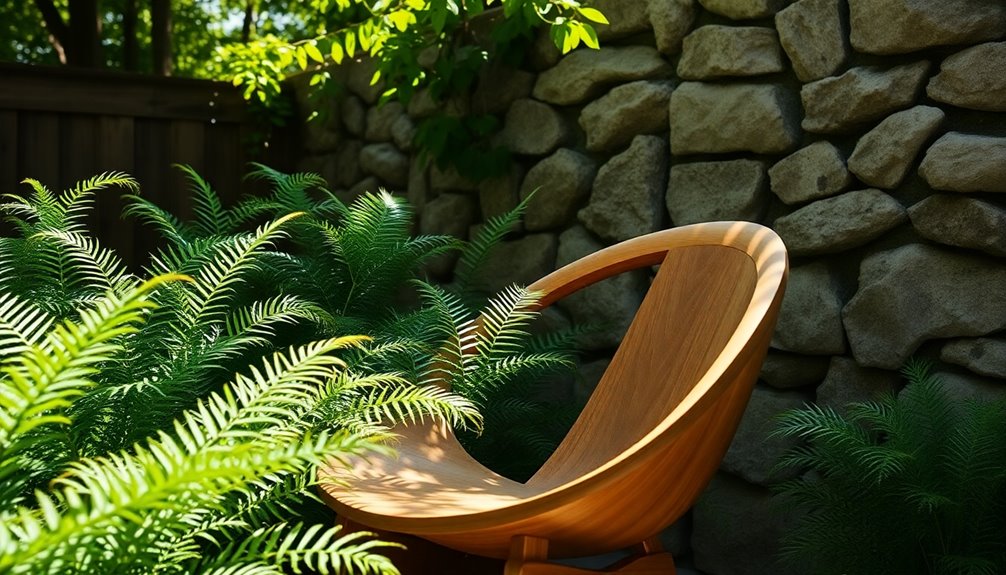
Incorporating natural materials into design not only enhances the aesthetic appeal of a space but also fosters a deeper connection to the environment. By choosing sustainable choices like wood, stone, and organic textiles, you create eco-friendly designs that promote a healthier indoor atmosphere. Layering textures, such as combining smooth wood with rough stone, adds visual interest and warmth to minimalist spaces while maintaining functionality. Additionally, the use of natural elements in decor promotes tranquility and enhances the overall ambiance of your home.
| Natural Material | Benefits |
|---|---|
| Wood | Adds warmth, tactile experience |
| Stone | Provides durability, textural contrast |
| Bamboo | Eco-friendly, lightweight, versatile |
| Cork | Sustainable, sound-absorbent |
| Organic Textiles | Enhances comfort, reduces synthetics |
Embracing these materials aligns with the principles of organic modern design, celebrating both simplicity and nature's inherent beauty.
The Importance of Earthy Color Palettes
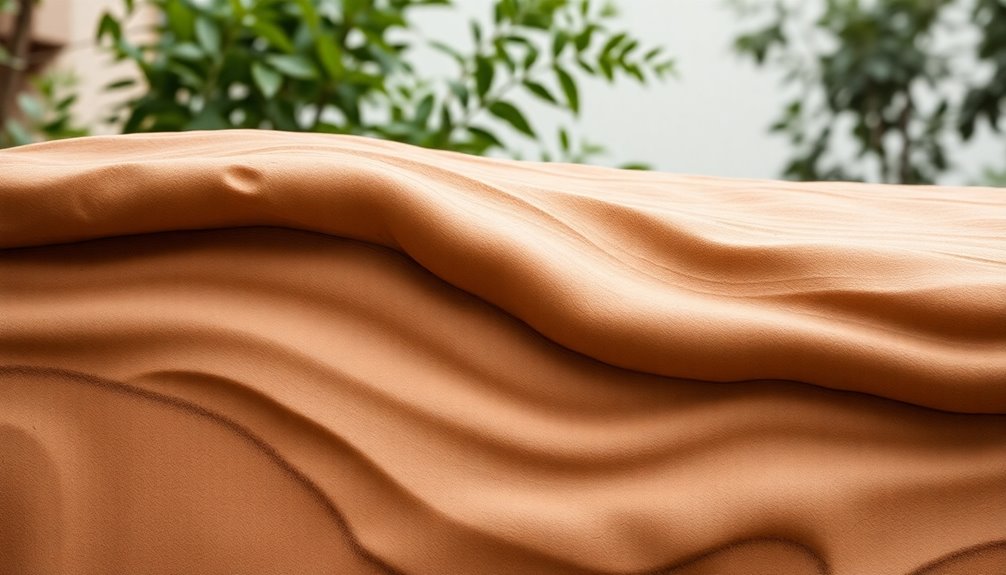
Choosing natural materials sets the stage for an earthy color palette that enhances the overall design.
By incorporating shades like beige, soft browns, muted greens, and warm grays, you create a calming atmosphere that reflects nature's beauty. This palette fosters a connection to nature and promotes inviting living spaces.
Incorporating beige, soft browns, muted greens, and warm grays cultivates a serene atmosphere, drawing inspiration from nature's beauty.
Here are three ways to utilize an earthy color palette effectively:
- Layering Textures: Combine neutral colors with organic materials for depth and richness.
- Monotone Scheme: Use subtle variations in earthy tones to enhance visual depth while keeping a serene environment.
- Seamless Flow: Guarantee consistent use of earthy colors to reinforce the organic aesthetic throughout your home, enhancing comfort and minimalism. Additionally, incorporating natural materials like wood can further emphasize the organic forms in your design.
Creating Open and Airy Spaces
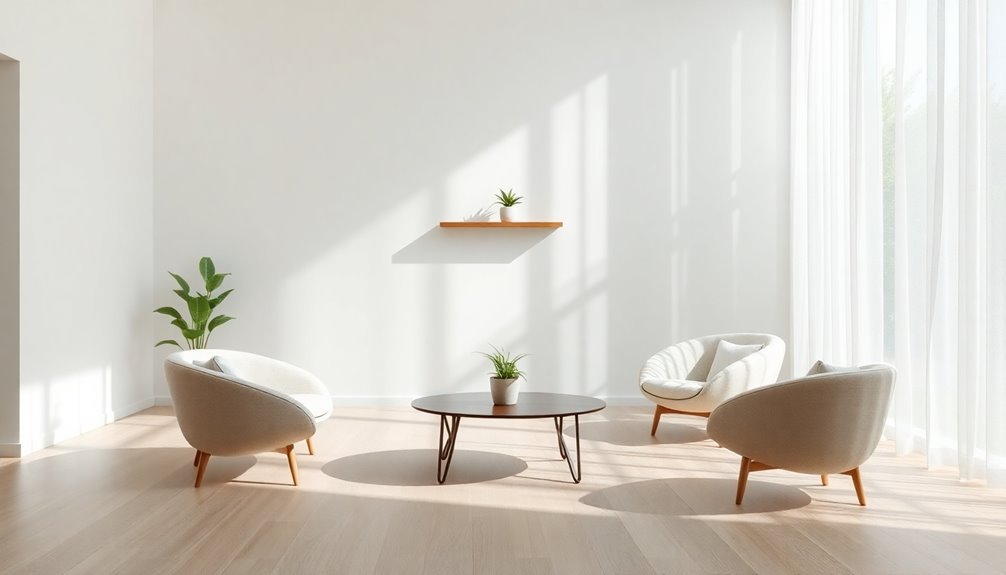
To create open and airy spaces in your home, start by removing unnecessary walls that can cramp the flow of natural light. Integrating large windows and sliding glass doors enhances the connection to nature, allowing for a seamless shift between indoors and outdoors. An open floor plan promotes community engagement while maintaining a spacious feel. Utilize a neutral color palette with soft, earthy tones to create a calming atmosphere. Don't forget to incorporate indoor plants; they not only beautify but also improve air quality. Additionally, consider employing innovative interior design ideas to further enhance the openness and functionality of your space.
| Element | Benefits | Tips |
|---|---|---|
| Large Windows | Enhances natural light | Position for ideal views |
| Neutral Color Palette | Creates calm environments | Choose soft, muted tones |
| Indoor Plants | Improves air quality | Select low-maintenance types |
Enhancing Interiors With Textural Diversity
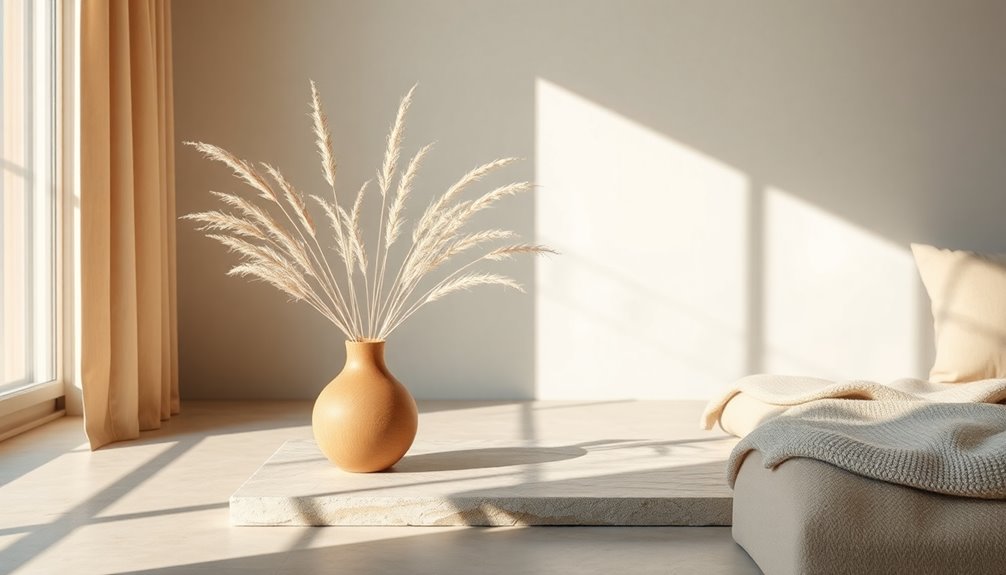
To create a visually enchanting interior, you can layer textures strategically by mixing smooth and rough materials. For instance, pairing sleek leather with rugged stone not only adds depth but also enhances the overall aesthetic. Incorporating natural elements like woven baskets can further enrich the textural diversity and create a warm, inviting atmosphere.
Layering Textures Strategically
While minimalism often emphasizes simplicity, layering textures strategically can transform a space into a warm and inviting environment.
By incorporating various materials, you can create depth and richness in your interiors. Here are three effective ways to achieve this:
- Combine Natural Fabrics: Use linen, cotton, and wool in cushions and throws to add coziness to minimalist designs.
- Contrast Textures: Pair sleek leather with chunky knit throws or smooth stone countertops with reclaimed wood furniture for visual interest.
- Utilize Accessories: Incorporate woven baskets, rugs, and wall hangings to enhance your cohesive design while maintaining the focus on simplicity.
This approach not only supports organic modern design but also makes your space feel more inviting and comfortable.
Balancing Smooth and Rough
Incorporating a mix of smooth and rough textures can elevate your minimalist space, making it feel both dynamic and inviting.
By blending various textures, like sleek leather with chunky knit throws, you create depth and visual interest while maintaining a minimalist aesthetic.
Textural contrasts, such as polished concrete countertops paired with reclaimed wood shelves, evoke warmth and richness, enhancing the organic modern design.
Adding woven baskets and plush rugs alongside smooth furniture fosters a cozy atmosphere, inviting interaction.
Emphasizing textural diversity not only boosts aesthetic appeal but also enriches the sensory experience, connecting you to the natural world.
Consider integrating elements like air purifiers that improve indoor air quality while complementing your design aesthetic.
Embrace these design principles to create a harmonious balance that feels both sophisticated and welcoming.
Sustainable Practices in Nature-Inspired Design

Sustainable practices in nature-inspired design not only enhance aesthetic appeal but also prioritize the health of our planet.
By embracing eco-friendly choices, you create spaces that reflect organic forms while reducing environmental impact.
Embracing eco-friendly choices crafts harmonious spaces that echo nature while minimizing our ecological footprint.
Here are three effective sustainable practices to contemplate:
- Use FSC-certified wood and reclaimed resources to minimize deforestation and promote responsible sourcing.
- Incorporate low-VOC paints and finishes to improve indoor air quality, ensuring a healthier environment for you and your loved ones.
- Opt for energy-efficient lighting solutions, like LED bulbs, to lower energy consumption and support eco-friendly living. Additionally, consider integrating efficient wood stoves into your design for a sustainable heating solution that reduces reliance on fossil fuels.
Real-Life Examples of Organic Minimalist Interiors
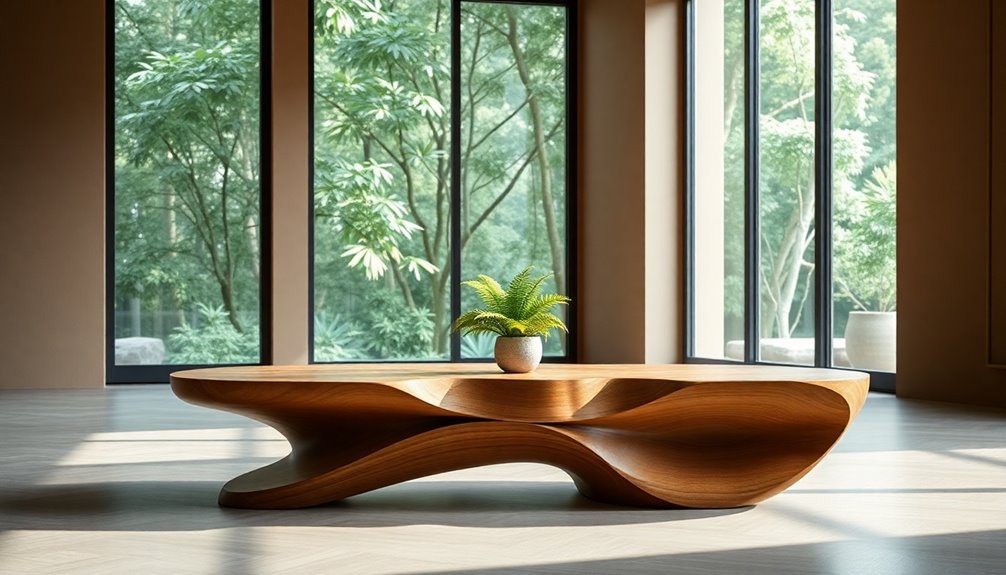
When you step into an organic minimalist interior, you instantly feel a sense of calm and connection to nature.
These spaces often feature reclaimed wood furniture, showcasing sustainability while adding unique character. Large windows enhance indoor-outdoor connections, flooding the room with natural light and allowing for seamless shifts between the interior and the outdoors.
The use of earthy color palettes—soft whites, muted greens, and warm browns—evokes tranquility, creating a soothing backdrop.
Textures are essential, blending smooth stones, rough wood, and soft textiles for a tactile experience.
Handcrafted decor, like artisanal ceramics and handwoven baskets, emphasizes the beauty of natural materials, enhancing the organic minimalist aesthetic and inviting you to embrace simplicity and comfort.
Frequently Asked Questions
What Is Organic Minimalist Design?
Organic minimalist design blends natural elements with modern aesthetics, creating spaces that feel both inviting and calming.
You'll appreciate the use of materials like wood and stone, which foster a connection to nature. Soft, neutral colors enhance tranquility, while functional simplicity keeps your environment clutter-free.
Incorporating indoor plants and natural light not only brightens your space but also promotes well-being, making it a perfect choice for a serene and stylish home.
What Is Organic Natural Style?
Organic natural style blends the rigidness of modern design with the softness of nature.
You'll find spaces that invite warmth through materials like wood and stone, creating a serene environment.
Using soft, neutral palettes, this style evokes tranquility.
Incorporating greenery and organic shapes enhances the connection to the outdoors.
What Is Organic Design?
Organic design focuses on creating spaces that harmonize with nature.
You'll notice it incorporates natural materials like wood and stone, blending them seamlessly into architecture and interiors. The shapes often mimic organic forms, offering a contrast to rigid designs.
By emphasizing sustainability and eco-friendliness, organic design encourages you to use reclaimed and sustainably sourced materials.
Ultimately, it aims to foster a connection to nature while enhancing your emotional well-being in your surroundings.
What Is Organic Decorating?
Organic decorating's all about embracing earthy elements and enhancing your environment.
You'll find natural materials like wood and stone, creating warm, welcoming spaces that connect you to nature.
By choosing soothing shades of brown and green, you promote peace and tranquility in your home.
This style prioritizes practicality and simplicity, encouraging you to declutter and focus on beautiful, functional furnishings.
Plus, it champions sustainability, using eco-friendly materials that benefit the planet.
Conclusion
Incorporating nature-inspired minimalism into your space not only fosters tranquility but also enhances your well-being. Did you know that studies show incorporating plants can boost your mood and productivity by up to 15%? By embracing organic forms, earthy colors, and natural materials, you create a serene environment that connects you to the outdoors. This design philosophy encourages a sustainable lifestyle while celebrating the beauty of simplicity, making your home a peaceful retreat.
